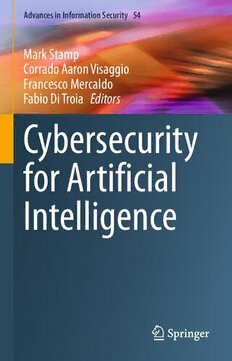Table Of ContentAdvances in Information Security 54
Mark Stamp
Corrado Aaron Visaggio
Francesco Mercaldo
Fabio Di Troia Editors
Cybersecurity
for Artificial
Intelligence
Advances in Information Security
Volume 54
SeriesEditor
SushilJajodia,GeorgeMasonUniversity,Fairfax,VA,USA
The purpose of the Advances in Information Security book series is to establish
the state of the art and set the course for future research in information security.
Thescopeofthisseriesincludesnotonlyallaspectsofcomputer,networksecurity,
andcryptography,butrelatedareas,suchasfaulttoleranceandsoftwareassurance.
Theseriesservesasacentralsourceofreferenceforinformationsecurityresearch
anddevelopments.Theseriesaimstopublishthoroughandcohesiveoverviewson
specific topics in Information Security, as well as works that are larger in scope
than survey articles and that will contain more detailed background information.
The series also provides a single point of coverage of advanced and timely topics
and a forum for topics that may not have reached a level of maturity to warrant a
comprehensivetextbook.
Mark Stamp • Corrado Aaron Visaggio
Francesco Mercaldo • Fabio Di Troia
Editors
Cybersecurity for Artificial
Intelligence
Editors
MarkStamp CorradoAaronVisaggio
SanJose,CA,USA Benevento,Italy
FrancescoMercaldo FabioDiTroia
Campobasso,Italy SanJose,CA,USA
ISSN1568-2633 ISSN2512-2193 (electronic)
AdvancesinInformationSecurity
ISBN978-3-030-97086-4 ISBN978-3-030-97087-1 (eBook)
https://doi.org/10.1007/978-3-030-97087-1
©TheEditor(s)(ifapplicable)andTheAuthor(s),underexclusivelicensetoSpringerNatureSwitzerland
AG2022
Thisworkissubjecttocopyright.AllrightsaresolelyandexclusivelylicensedbythePublisher,whether
thewholeorpartofthematerialisconcerned,specificallytherightsoftranslation,reprinting,reuse
ofillustrations,recitation,broadcasting,reproductiononmicrofilmsorinanyotherphysicalway,and
transmissionorinformationstorageandretrieval,electronicadaptation,computersoftware,orbysimilar
ordissimilarmethodologynowknownorhereafterdeveloped.
Theuseofgeneraldescriptivenames,registerednames,trademarks,servicemarks,etc.inthispublication
doesnotimply,evenintheabsenceofaspecificstatement,thatsuchnamesareexemptfromtherelevant
protectivelawsandregulationsandthereforefreeforgeneraluse.
Thepublisher,theauthorsandtheeditorsaresafetoassumethattheadviceandinformationinthisbook
arebelievedtobetrueandaccurateatthedateofpublication.Neitherthepublishernortheauthorsor
theeditorsgiveawarranty,expressedorimplied,withrespecttothematerialcontainedhereinorforany
errorsoromissionsthatmayhavebeenmade.Thepublisherremainsneutralwithregardtojurisdictional
claimsinpublishedmapsandinstitutionalaffiliations.
ThisSpringerimprintispublishedbytheregisteredcompanySpringerNatureSwitzerlandAG
Theregisteredcompanyaddressis:Gewerbestrasse11,6330Cham,Switzerland
Preface
Weareonthecuspofarevolutioninartificialintelligence(AI).Today,AIplaysa
significant role in daily life, and the impact of AI is sure to increase dramatically
overthecomingyears.Perhapssurprisingly,theneteffectofthisAIrevolutionon
cybersecurity is, at present, unclear, as both the “good guys” and the “bad guys”
canemploysuchtechnology.IfcybersecurityistoreapmajorbenefitsfromAI,the
technologyitselfmustbebetterunderstood—blackboxesareinherentlytheenemy
ofsecurity.
Models used in AI are notoriously opaque, which creates numerous potential
problems. From a cybersecurity perspective, one of the greatest of these problems
isthethreatofadversarialattacks.Itfollowsthat“explainableAI,”forexample,is
offundamentalimportanceininformationsecurity.
ThisbookincludeschaptersthatattempttoilluminatevariousaspectsoftheAI
blackboxesthathavecometodominatecybersecurity.ThetopicsofexplainableAI
andadversarialattacks—aswellasthecloselyrelatedissueofmodelrobustness—
areconsidered.Mostofthechaptersexploretheseandsimilartopicsinthecontext
of specific security threats. The security domains considered include such diverse
areas as malware, biometrics, and side-channel attacks, among others. We have
strivedtomakethematerialaccessibletothewidestpossibleaudienceofresearchers
andpractitioners.
Weareconfidentthatthisbookwillprovevaluabletopractitionersworkinginthe
fieldandtoresearchersinbothacademiaandindustry.Thechaptersincludeinsights
thatshouldhelptoilluminatesomeofthedarkestcornersofpopularAImodelsthat
areusedincybersecurity.
SanJose,CA,USA MarkStamp
Benevento,Italy CorradoAaronVisaggio
Campobasso,Italy FrancescoMercaldo
SanJose,CA,USA FabioDiTroia
December2021
v
Contents
PartI Malware-RelatedTopics
GenerationofAdversarialMalwareandBenignExamplesUsing
ReinforcementLearning......................................................... 3
MatoušKozák,MartinJurecˇek,andRóbertLórencz
1 Introduction .................................................................. 3
2 Background .................................................................. 5
2.1 AdversarialMachineLearning........................................ 5
2.2 ReinforcementLearning............................................... 6
2.3 PortableExecutableFileFormat...................................... 8
3 Implementation .............................................................. 8
3.1 Overview............................................................... 9
3.2 Dataset ................................................................. 9
3.3 PEFileModifications ................................................. 9
3.4 TargetClassifier........................................................ 10
3.5 AgentandItsEnvironment............................................ 11
4 Evaluation.................................................................... 11
4.1 AdversarialMalwareExamples....................................... 12
4.2 AdversarialBenignExamples......................................... 17
5 RelatedWork................................................................. 20
5.1 Gradient-BasedAttacks ............................................... 20
5.2 ReinforcementLearning-BasedAttacks.............................. 20
5.3 OtherMethods......................................................... 21
6 Conclusion ................................................................... 22
6.1 FutureWork............................................................ 23
References ......................................................................... 23
Auxiliary-ClassifierGANforMalwareAnalysis ............................. 27
RakeshNagarajuandMarkStamp
1 Introduction .................................................................. 27
2 RelatedWork................................................................. 28
vii
viii Contents
3 Methodology................................................................. 30
3.1 Data..................................................................... 30
3.2 AC-GAN............................................................... 31
3.3 EvaluationPlan ........................................................ 33
3.4 Accuracy............................................................... 35
4 Implementation .............................................................. 36
4.1 DatasetAnalysisandConversion..................................... 37
4.2 AC-GANImplementation............................................. 38
4.3 EvaluationModels..................................................... 40
5 ExperimentalResults ........................................................ 42
5.1 AC-GANExperiments ................................................ 42
5.2 CNNandELMExperiments.......................................... 48
6 ConclusionandFutureWork................................................ 65
References ......................................................................... 66
AssessingtheRobustnessofanImage-BasedMalwareClassifier
withSmaliLevelPerturbationsTechniques................................... 69
GiacomoIadarola,FabioMartinelli,AntonellaSantone,andFrancesco
Mercaldo
1 Introduction .................................................................. 69
2 BackgroundandRelatedWorks............................................. 71
2.1 StaticMalwareAnalysis............................................... 71
2.2 ConvolutionalNeuralNetwork ....................................... 72
2.3 DalvikVMandDalvikEXecutable................................... 74
2.4 Image-BasedMalwareClassification................................. 75
3 Methodology................................................................. 76
3.1 UntargetedMisclassification.......................................... 78
4 ImplementationandExperiments........................................... 80
5 ConclusionandFutureWork................................................ 82
References ......................................................................... 82
DetectingBotnetsThroughDeepLearningandNetworkFlowAnalysis.. 85
JiAnLeeandFabioDiTroia
1 Introduction .................................................................. 85
2 Background .................................................................. 86
2.1 IntroductiontoBotnets................................................ 87
2.2 AutocorrelationAnalysis.............................................. 88
2.3 DeepNeuralNetworks ................................................ 89
3 RelatedWork................................................................. 90
4 Dataset........................................................................ 91
4.1 CTU-13DatasetFeatures ............................................. 92
5 ProposedMethodology...................................................... 92
5.1 DataPreprocessingPhase............................................. 94
5.2 DeepLearningPhase.................................................. 99
Contents ix
6 Results........................................................................ 101
7 Conclusions .................................................................. 103
References ......................................................................... 103
InterpretabilityofMachineLearning-BasedResultsofMalware
DetectionUsingaSetofRules.................................................. 107
JanDolejšandMartinJurecˇek
1 Introduction .................................................................. 107
2 RelatedWorks................................................................ 109
3 Rule-BasedClassification ................................................... 110
3.1 FromTreestoRules................................................... 112
3.2 Rule-LearningAlgorithms ............................................ 113
4 ImplementationofRule-BasedClassifiers.................................. 115
4.1 DecisionList........................................................... 115
4.2 I-REP................................................................... 116
4.3 RIPPER ................................................................ 117
5 Experiments.................................................................. 118
5.1 DatasetDescription.................................................... 118
5.2 DataSplitting .......................................................... 119
5.3 FeatureTransformationandSelection................................ 120
5.4 EvaluationMetrics..................................................... 122
5.5 InterpretabilityofMachineLearningModels........................ 123
5.6 MeasuringPerformanceofRBCsonMLPredictions ............... 124
5.7 InterpretingMLResultsUsingRBCs ................................ 126
5.8 PruningandMetrics................................................... 128
5.9 DoesOrderoftheRulesMatter?...................................... 130
6 ConclusionandFutureWork................................................ 133
References ......................................................................... 135
MobileMalwareDetectionUsingConsortiumBlockchain.................. 137
GeorgeMartin,DonaSpencer,AdityaHair,DeepaK,SoniaLaudanna,
VinodP,andCorradoAaronVisaggio
1 Introduction .................................................................. 138
2 UseCase...................................................................... 139
3 AndroidApplicationComponents .......................................... 140
3.1 Activities............................................................... 140
3.2 Services ................................................................ 141
3.3 BroadcastReceivers................................................... 141
3.4 ContentProviders...................................................... 141
4 RoleinMalwareDetection.................................................. 141
5 TheBlockchainNetwork.................................................... 142
6 RelatedWorks................................................................ 143
7 Methodology................................................................. 144
7.1 APKFiles.............................................................. 145
7.2 TrustedServer ......................................................... 145
7.3 AddingaRecord....................................................... 145
x Contents
7.4 MembersoftheConsortium .......................................... 146
7.5 BlockchainLedger..................................................... 146
7.6 FinalResponse......................................................... 146
7.7 TechnologyBehindBlockchainNetwork ............................ 147
8 ImplementationDetails...................................................... 149
8.1 Scenario1.............................................................. 149
8.2 Scenario2.............................................................. 151
8.3 InitializingBlockforUnknownapk.................................. 152
8.4 UpdatingBlockwithVoteandFeatures.............................. 153
8.5 SettingtheStateoftheapkAfterCountingAlltheVotes........... 154
9 FeatureExtractionandModelTraining..................................... 155
10 DatasetandExperimentation................................................ 156
11 Results........................................................................ 157
12 Conclusion ................................................................... 158
References ......................................................................... 159
BERTforMalwareClassification.............................................. 161
JoelAlvaresandFabioDiTroia
1 Introduction .................................................................. 161
2 RelatedWork................................................................. 162
3 Background .................................................................. 163
3.1 NLPModels ........................................................... 164
3.2 Classifiers .............................................................. 168
4 ExperimentsandResults .................................................... 171
4.1 Dataset ................................................................. 172
4.2 Methodology........................................................... 173
4.3 ClassifierParameters .................................................. 173
4.4 LogisticRegressionResults........................................... 174
4.5 SVMResults........................................................... 174
4.6 RandomForestResults................................................ 175
4.7 MLPResults ........................................................... 176
4.8 FurtherAnalysis ....................................................... 176
4.9 Summary............................................................... 178
5 ConclusionsandFutureWork............................................... 179
References ......................................................................... 180
MachineLearningforMalwareEvolutionDetection........................ 183
LolithaSrestaTupadhaandMarkStamp
1 Introduction .................................................................. 183
2 Background .................................................................. 185
2.1 Malware................................................................ 185
2.2 RelatedWork .......................................................... 186
2.3 Dataset ................................................................. 187
2.4 LearningTechniques .................................................. 189

